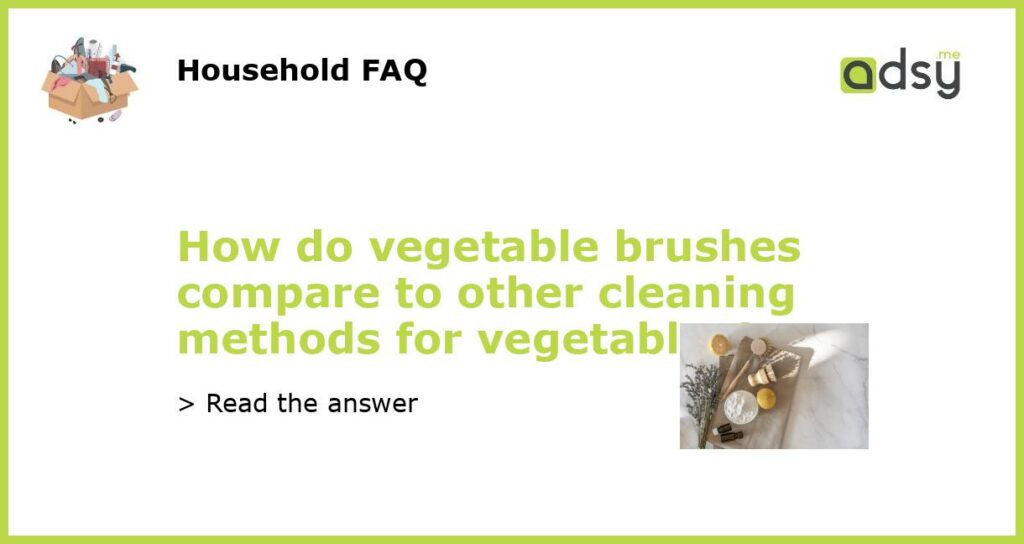Vegetable Brushes vs Other Cleaning Methods: Which is Better?
Keeping our vegetables clean and free from harmful contaminants is essential for maintaining good health. While there are various methods for cleaning vegetables, one popular option is using vegetable brushes. In this article, we will compare vegetable brushes to other cleaning methods to determine which is better.
The Effectiveness of Vegetable Brushes
Vegetable brushes are specifically designed to remove dirt, bacteria, and pesticides from the surface of vegetables. The bristles help in scrubbing away any impurities that may be present. When used correctly, vegetable brushes can be highly effective in cleaning vegetables thoroughly.
Most vegetable brushes have stiff bristles made from natural or synthetic materials. These bristles are strong enough to remove stubborn dirt while being gentle enough to avoid damaging the vegetables. They are especially useful for cleaning vegetables with rough or irregular surfaces, such as potatoes or carrots.
Comparison to Other Cleaning Methods
2.1. Running Water
One common method of cleaning vegetables is simply rinsing them under running water. While this method is quick and convenient, it may not be as effective as using a vegetable brush. Rinsing under running water may not completely remove dirt, bacteria, or pesticides from the surface of the vegetables.
Vegetable brushes, on the other hand, provide physical agitation that helps dislodge and remove contaminants. By using a brush, you can ensure a more thorough cleaning of your vegetables.
2.2. Soaking
Soaking vegetables in water or a cleaning solution is another popular cleaning method. This method can be effective in removing dirt and some pesticides. However, it may not be as effective in removing bacteria or other pathogens.
Vegetable brushes, with their bristles, are better equipped to remove bacteria and other contaminants from the surface of vegetables. By scrubbing the vegetables with a brush, you can target and remove harmful microorganisms effectively.
2.3. Vinegar Solution
Some people prefer using a vinegar solution to clean their vegetables. While vinegar has antimicrobial properties, it may not be as effective in removing dirt or additional pesticides. Using a vegetable brush in combination with a vinegar solution can provide a more thorough cleaning.
A vinegar solution can help kill certain bacteria and other pathogens. However, physically scrubbing the vegetables with a brush is necessary to remove dirt and other impurities effectively.
Considerations and Recommendations
When deciding which cleaning method to use for your vegetables, several factors should be considered:
3.1. Type of Vegetable
The type of vegetable being cleaned can impact the choice of cleaning method. Vegetables with rough surfaces, such as potatoes or root vegetables, may benefit from the use of a vegetable brush. Softer vegetables, like lettuce or spinach, may be more effectively cleaned through soaking or running water.
3.2. Contamination Concerns
If you are particularly concerned about bacteria or pesticide residues on your vegetables, using a vegetable brush would be a wise choice. The physical agitation provided by the brush can help remove these contaminants more effectively.
3.3. Personal Preference
Ultimately, the choice between using a vegetable brush and other cleaning methods may come down to personal preference. Some individuals may prefer the convenience of running water or soaking, while others prioritize thorough cleaning and prefer the use of a vegetable brush.
Conclusion
In conclusion, vegetable brushes can be highly effective in cleaning vegetables and removing dirt, bacteria, and pesticides. While other cleaning methods, such as running water or soaking, may be convenient, they may not provide the same level of thorough cleaning. By considering the type of vegetable and your contamination concerns, you can make an informed decision on which cleaning method to use. In most cases, using a vegetable brush as part of your vegetable cleaning routine is recommended for best results.






